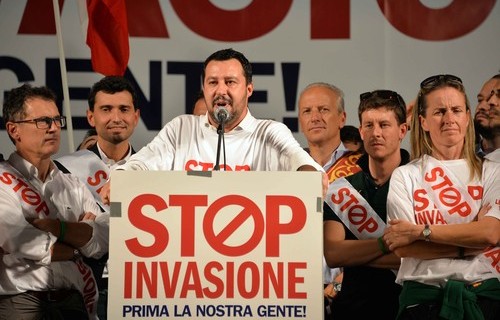Methodology and main findings
For investigation purposes, I decided to narrow my analysis to public transport. Means of transport are a closed social environment inhabited by strangers. It is a good lens of analysis because they are accessible and are used by a wide spectrum of society. Moreover, passengers are strangers in short, temporary contact, so their interactions are less likely to be influenced by close relations.
At first, I interviewed six passengers of different ages, both local and migrant, and from different areas of the city. Afterwards, I incorporated the findings for public transport into a broader framework of interactions among strangers.
I claim that insults and hostile behaviours stem from a widespread narrative of strangers as enemies. I do not claim that we should trust unknown people or hide the high number of crimes they commit.
However, they do not justify the deep distrust I recorded. This popularized narrative leads to insults, a language of violence, and hate speech, that create an actual hostile environment, fuelling a vicious circle. These behaviours are normalised, considered both ordinary and legitimised by the view of the Other as an enemy.
I argue that this mechanism in which language of violence and hate speech are enacted paves the way for physical violence. Narratives are the building blocks, the first steps. Authority and the dissemination through speeches or media are what turn these narratives into physical violence. Moreover, in an all-against-all environment, any group can be easily targeted by authorities.
If we popularise the narrative of the unknown as an enemy, threat, or danger, any group targeted by formal speeches or media becomes the real enemy by an uncritical judgement of the populace. I suggest that the normalization and discarding of hostile behaviours towards strangers as minor social issues constitute a serious threat.
Characteristics specific to buses
Before discussing the general modes of interactions between strangers, it is important to consider the specific context of buses. According to my interviewees, external factors like poor bus conditions, traffic, and non-respected rules can influence people’s behaviour. These factors can lead to stressful and anger-inducing situations.
“You know that on the street, you are stuck in traffic. And this will stress you and provoke distress».[1]
«There are few rules, but still, a lot of misunderstandings arise».[2]
«Means of transport are not considered a safe place. They don’t do what they promise, and there are all kinds of distress».[3]
On this topic, I would like to talk about my interviewees. At first, I was supposed to interview drivers of the Roman public transport. However, I discovered that the company prohibits them from being interviewed without the company’s authorization. When I tried to ask drivers to join the project they were scared of losing their jobs, even if they could be interviewed anonymously. When I ask the company the authorization to interview a bunch of drivers, they told me that I needed to start a procedure mutually agreed upon. In the end, I gave up due to the slow bureaucracy, which did not align with my project. Even if the large size of the company can justify the slowness of the bureaucracy, I found out that 6 years ago a driver was fired after an interview where she denounced to a journal the bad conditions of the buses[4].
Could all these facts together be an indication of poor bus conditions in Rome?

Means of transport are hostile
The means of transport and buses are perceived as hostile environments. I asked the interviewees whether they witnessed episodes of anger or hostility on buses, and they answered: «Definitely[5]», «All the time. It happens every day[6]» «Absolutely[7]» «There are plenty of reasons for arguments on buses(…) people just start insulting you. It happens daily».[8]
Till now it is not big news. Numerous studies on episodes of violence on buses show how public transports are exposed to many violent or criminal situations[9]. However, to what extent does the narration of hostility adhere to the facts?
Distrust, Isolation, Carelessness
The predominant sentiment expressed by the interviewees is an attitude of vigilance and mutual distrust. Passengers tend not to socialize, and when they do, it is not considered usual or something they should do.
«You don’t talk with people on buses. There is always an individual relationship and isolation(…), which leads more and more to closure towards others and distrust ».[10]
«When someone is kind to me on buses, I am almost scared. I always think bad things».[11]
«We are prejudiced. I assume that you don’t care at all about what I think. So, we start by insulting each other, and then maybe we can start to dialogue».[12]

Moreover, anonymity plays a role. I interviewed an American girl who recently moved to Rome and asked for her outsider perspective:
« I see an overall attitude in Rome that “this is another person who I will not see again, so who cares? I don’t care about this individual”. (…) It’s very much “don’t bother anybody else”; this is the American mentality. What I have seen is that the Romans don’t care about anybody else».[13]
In sum, the interviewees expressed a lack of integrity in this social context, feelings of distrust, isolation, and indifference towards strangers.
The witnessed episodes
All the interviewees witnessed episodes of anger, verbal abuse, or hostility on public transport.
«It can happen that when there are immigrants on buses, I hear people loudly saying “Look at how many migrants. If there were none, the bus wouldn’t be overcrowded and we would feel better».[14]
«I don’t like ticket collectors at all. They are arrogant and aggressive, with a sense of minor power that usually leads them to use a loud tone unnecessarily».[15]
Also, another interviewee sensed that ticket collectors are not that present in suburbs because they are scared of possible violent reactions towards them.[16]
«When I was younger, an older woman insulted me because I hadn’t enough time to stand up and let them sit down».[17]
« Once, a girl bumped into another girl, leading to a hostile argument because the former was accused of pickpocketing the latter.[18]»
« Once, I saw a man step onto a girl’s veil, probably Muslim, and when he stepped on her dress, he accidentally pulled it down a little. The girl got furious because she was worried her veil would fall off. She was super upset with the boy, but he looked genuinely sorry».[19]
« I noticed that drivers are insulted daily for any reason; it doesn’t matter if they do their job correctly or not».[20]
Finally, I once witnessed a group of girls talking loudly on a bus. An older woman told them to shut up in a rude tone. The girls started talking more loudly shouting at the old woman to mind her business.
It seems that any strangers, besides their appearance or actions, are a potential threat and can be blamed for incorrect behaviours.
Are these behaviours just stress-provoked or related to bus conditions and traffic? Is it just about widespread rudeness or lack of education to anger? Should we care about these interactions?
The Other
I want to bring attention to Irm Haleem’s studies on normalization of violence[21]. Haleem talks about the process of violence. This process is “that stage before violence actually manifests itself physically”, and functions to normalize violence.
This process first manufactures enemies through narratives of violence and then manufactures consent for violence against those designated enemies through dissemination.
The process follows a precise structure. Firstly, the narratives of violence are created by language of violence. The other is equated to an inferior being in the step of moralization. As a result, social interactions adapt to the belief of the self as righteous as opposed to the other as immoral in the step of legalisation. Finally, this narrative is popularized.
Once the enemy is manufactured effective dissemination begins, through media, speeches, declarations, and iconography.
How is this linked to insults on buses?
As previously mentioned, the common element to the interviews is that any stranger is arbitrarily regarded as a possible danger, so, it is legitimate to accuse or behave incorrectly towards them. These episodes depict the other as a threat, in moral terms “the evil”. Therefore, people feel legitimized for overreacting or behaving hostilely. These factors are common to all the episodes. It is clear, then, that these are the steps Irm Haleem talks about. I claim that people create a narrative of violence related to strangers using a language of violence. Moreover, what is also interesting is that this process creates a vicious circle.
When insults and hostile behaviours enter the ordinary and are considered the norm, they create an actual hostile environment which reinforces the perception of the other as the cause of any minor inconvenience.
The interviews include narratives where migrants overcrowd buses, bus drivers not doing their job correctly, ticket collectors abusing power, and people possibly have violent behaviours towards them. But also young people being selfish not letting the weaker seat, old people not minding their business, and random girls accused of pickpocketing.
Can actually everyone be so mean?

Let’s compare with facts
Strangers are authors of violent behaviours, both on buses and out.
Let’s take sexual molestation as an example. The Italian National Institution of Statistics (ISTAT) widely researched on this topic. Thousands of men and women aged between 14 and 70 were interviewed about sexual molestation episodes. Overall, data show that strangers are the most likely authors of sexual molestation (76,8%)[22]. Strangers committed 69,3% of sexual molestation with contact with women[23]. 29,6% of them happened on buses or stations. Contrarily the number plunged for men, with 55% of strangers-made molestation and 3,8% of them in public transport or station. [24] On a different topic, Rome is the third city in Italy for crime rate and the number of crimes denounced to the police in 2022 was about 231 293[25].
So, again, I am not claiming that Rome and buses are the safest place in the world.
However, what I also point out is that, according to this study, the authors of the most severe form of violence are not strangers, but partners (62,7%)[26].
Moreover, even if the number of crimes denounced is high, this does not legitimize the continuous state of alert and distrust commonly perceived.
How does this influence our reality?
According to the previous paragraphs, insults result from a popularized and legitimized narrative of the other as an enemy. This feeling can be partly justified by data on actual crimes, but not totally. The narrative constructed by language of violence plays a pivotal role.
I interviewed six passengers and one of them is a non-Italian speaker who recently moved to Rome. When I asked them about their perception of the behaviour between passengers, they said they met a lot of nice people[27], and did not consider buses a hostile environment. This is a limited source because it might be influenced by the subjectivity of this person, but it is useful anyway. Either this person has been insulted and did not understand, or in lack of prejudice, they had a different experience. This is evidence that narratives and language do shape our world.
Hate speech, Authority, and Physical Violence
Besides the numerous episodes of verbal violence and the rooted perception of buses as hostile environments, most of the interviewees did not witness physical violence. According to Haleem, for physical violence to flourish, dissemination of such narrative is needed through media, speeches, and declarations. To quote Rae Langton, ” Words can do much more to people when they have authority”[28]. When the language of violence is used by common people on buses they concur to popularize an all-against-all narrative. Numerous different enemies are manufactured, they can be old, young, migrants, local, of any gender, of any role, doing anything. Some narratives may gain informal authority from the hearers, and others may not. The power conferred to these words is in the passengers’ hands.
By contrast, what happens when some language of violence towards specific categories is tolerated, if not encouraged by institutions, through, for instance, formal speeches? The answer may be straightforward: it leads to physical violence.
Once a man said: “Ask the doctors who bring us scabies and tuberculosis. They don’t come from Switzerland, they come from Africa(…)”.[29]
That man’s name is Matteo Salvini. Nowadays Matteo Salvini is the Italian Vice President of the Council of Ministers.

Final remarks
I have been told my whole life that I should be less sensitive and understand that the world is tough. We cannot be kind all the time and it happens to everyone to insult strangers. After all, bad words are not a big deal and I have to learn they are ordinary; sometimes, I have to expect such reactions. However, I am not sure this is good advice for life. The words we use and hear every day shape our world. If misused, they can lead to physical violence. We have built an all-against-all narrative that allows institutions to easily target anyone they want. People are not “too sensitive” and they are not “just bad days”. They are not just insults.
Footnotes
[1] Interview with passenger 1 [17/06/2024]
[2] Interview with passenger 6 [22/05/2024]
[3] Interview with passenger 3 [17/06/2024]
[4] Redazione. (2018, September 25). Dopo la sospensione Atac licenzia Micaela Quintavalle: “Impugnerò il provvedimento.” RomaToday. https://www.romatoday.it/politica/micaela-quintavalle-licenziata.html
[5] Interview with passenger 1 [17/06/2024]
[6] Interview with passenger 3 [17/06/2024]
[7] Interview with passenger 5 [22/06/2024]
[8] Interview with passenger 6 [22/05/2024]
[9] s.s Ciampi L, Foszner P, Messina N, Staniszewski M, Gennaro C, Falchi F, Serao G, Cogiel M, Golba D, Szczęsna A, et al. (2022). Bus Violence: An Open Benchmark for Video Violence Detection on Public Transport. Sensors. 2022; 22(21):8345. https://doi.org/10.3390/s22218345).
[10] Interview with passenger 5 [22/06/2024]
[11] Interview with passenger 3 [17/06/2024]
[12] Interview with passenger 6 [22/05/2024]
[13] Interview with passenger 4 [19/06/2024]
[14] Interview with passenger 3 [17/06/2024]
[15] Interview with passenger 5 [22/06/2024]
[16] Interview with passenger 1 [17/06/2024]
[17] Interview with passenger 5 [22/06/2024]
[18] Interview with passenger 4 [19/06/2024]
[19] Interview with passenger 2 [17/06/2024]
[20] Interview with passenger 6 [22/05/2024]
[21] Haleem, I. (2020). How Violence is Normalized: On the Process of Violence. Routledge.
[22] Violenza sulle donne: 6,7 milioni le vittime. Gli autori: partner attuali o ex. Lo dice l’Istat. (2015, June 5). Sanità24. https://www.sanita24.ilsole24ore.com/art/dal-governo/2015-06-05/violenza-donne-67-milioni-vittime-autori-partner-attuali-o-ex-dice-l-istat-121631.php?uuid=ABwnb3sD
[23] Istat. (n.d.-c). LE MOLESTIE: VITTIME e CONTESTO | ANNO 2022-2023. In https://www.istat.it/wp-content/uploads/2024/07/REPORT-Molestie.pdf.
[24] Istat. (n.d.-c). LE MOLESTIE: VITTIME e CONTESTO | ANNO 2022-2023. In https://www.istat.it/wp-content/uploads/2024/07/REPORT-Molestie.pdf.
[25] Istat. (n.d.-b). Delitti denunciati dalle forze di polizia all’autorità giudiziaria. © OECD. http://dati.istat.it/Index.aspx?DataSetCode=DCCV_DELITTIPS
[26] Violenza sulle donne: 6,7 milioni le vittime. Gli autori: partner attuali o ex. Lo dice l’Istat. (2015, June 5). Sanità24. https://www.sanita24.ilsole24ore.com/art/dal-governo/2015-06-05/violenza-donne-67-milioni-vittime-autori-partner-attuali-o-ex-dice-l-istat-121631.php?uuid=ABwnb3sD
[27] Interview with passenger 2 [17/06/2024]
[28] Integrity 20. (2018, June 18). Rae Langton | The authority of hate speech [Video].
[29]Italia, H. (2014, May 6). Matteo Salvini contro gli immigrati: “Darei a loro il Daspo: portano scabbia, tubercolosi ed ebola” (VIDEO). HuffPost Italia. https://www.huffingtonpost.it/politica/2014/05/06/news/matteo_salvini_contro_gli_immigrati_darei_a_loro_il_daspo_portano_scabbia_tubercolosi_ed_ebola_-6470532/
Bibliography
Sociologist studies the unwritten rules of riding the bus – Faculty of Arts. (n.d.). Faculty of Arts. https://www.arts.ubc.ca/news/sociologist-studies-the-unwritten-rules-of-riding-the-bus/
Redazione. (2018, September 25). Dopo la sospensione Atac licenzia Micaela Quintavalle: “Impugnerò il provvedimento.” RomaToday. https://www.romatoday.it/politica/micaela-quintavalle-licenziata.html
s.s Ciampi L, Foszner P, Messina N, Staniszewski M, Gennaro C, Falchi F, Serao G, Cogiel M, Golba D, Szczęsna A, et al. (2022). Bus Violence: An Open Benchmark for Video Violence Detection on Public Transport. Sensors. 2022; 22(21):8345. https://doi.org/10.3390/s22218345).
Haleem, I. (2020). How Violence is Normalized: On the Process of Violence. Routledge.
Istat. (n.d.-c). LE MOLESTIE: VITTIME e CONTESTO | ANNO 2022-2023. In https://www.istat.it/wp-content/uploads/2024/07/REPORT-Molestie.pdf.
Violenza sulle donne: 6,7 milioni le vittime. Gli autori: partner attuali o ex. Lo dice l’Istat. (2015, June 5). Sanità24. https://www.sanita24.ilsole24ore.com/art/dal-governo/2015-06-05/violenza-donne-67-milioni-vittime-autori-partner-attuali-o-ex-dice-l-istat-121631.php?uuid=ABwnb3sD
Istat. (n.d.-b). Delitti denunciati dalle forze di polizia all’autorità giudiziaria. © OECD. http://dati.istat.it/Index.aspx?DataSetCode=DCCV_DELITTIPS
Istat. (n.d.). Aspetti della vita quotidiana : fiducia negli altri – età dettaglio. © OECD. http://dati.istat.it/Index.aspx?QueryId=24326
Integrity 20. (2018, June 18). Rae Langton | The authority of hate speech [Video]. YouTube. https://www.youtube.com/watch?v=AEhNsR3iPqQ
Italia, H. (2014, May 6). Matteo Salvini contro gli immigrati: “Darei a loro il Daspo: portano scabbia, tubercolosi ed ebola” (VIDEO). HuffPost Italia. https://www.huffingtonpost.it/politica/2014/05/06/news/matteo_salvini_contro_gli_immigrati_darei_a_loro_il_daspo_portano_scabbia_tubercolosi_ed_ebola_-6470532/












This topic is undoubtedly unique and the way in which you approach it is incredibly engaging and relevant. Your choice of the bus as an interview setting complemented your motif of stranger hostility well and expands the discourse to a variety of people and backgrounds. Additionally, the bus setting adds a certain informality to the article that allowed me to contextualize the experiences. The setting along with the interviews themselves, bring into perspetive how this is a truly personal and mundane phenomenon. Particularly, the nod to external factors, like traffic, was an insightful addition that is relatable to a general audience and myself.